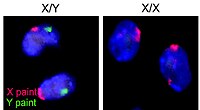
Photo from wikipedia
The bottlenose dolphin (Tursiops truncatus) is a common species in coastal temperate waters and the ideal candidate for developing a conceptual bioenergetic model given that sufficient information is available to… Click to show full abstract
The bottlenose dolphin (Tursiops truncatus) is a common species in coastal temperate waters and the ideal candidate for developing a conceptual bioenergetic model given that sufficient information is available to parameterize key input variables. A bioenergetic model was developed to estimate annual energy requirements (MJ/year) and prey biomass consumption (t/year) based on model variations of Field Metabolic Rates (FMR) that included percent of body mass (FMRBodyMass), Kleiber’s scaling equation (FMRKleiber), and measured FMRs (FMRMeasured). Bioenergetic requirements were generated by incorporating the intrinsic uncertainty of input model variables based on assumed or data-driven assignments of sampling distributions. Gompertz growth functions were used to generate body lengths (cm) as a function of age, which once converted to body mass (kg), were used in all calculations. Annual bioenergetic estimates differed across model variations (FMRMeasured>FMRKleiber>FMRBodyMass) and were on average 22%–34% higher in female calves than in male calves, 3%–7% higher in subadult/immature females than in males, and 12%–18% higher in adult males than in non-lactating adult females. Average estimates were ∼72% and 31%–34% higher in lactating adult females compared to non-lactating adult females and adult males, respectively. Annual bioenergetic requirements for ≥2year old dolphins normalized by body mass were FMRMeasured: 205±29MJ/kg/year and 34±5kg/kg/year, FMRKleiber: 151±29MJ/kg/year and 22±5kg/kg/year, and FMRBodyMass: 138±38MJ/kg/year and 20±5kg/kg/year. When applying the bioenergetic model to the US bottlenose dolphin stock with the largest dolphin abundance (n=950), estimates of annual bioenergetic requirements were 2040–3050 MJ*104/year and 2900–5070t/year. While the existing information provides the foundation to develop a bioenergetic model specific for bottlenose dolphins, improvements of this and related models require additional data on field measurements of metabolic rates, cost of lactation, caloric intake and metabolization efficiency. This bioenergetic model could be used to better understand the complex ecological and trophic interactions of bottlenose dolphins with their prey populations, to evaluate the role of disturbance on bioenergetic requirements, and to inform management and conservation efforts.
Journal Title: Ecological Modelling
Year Published: 2017
Link to full text (if available)
Share on Social Media: Sign Up to like & get
recommendations!